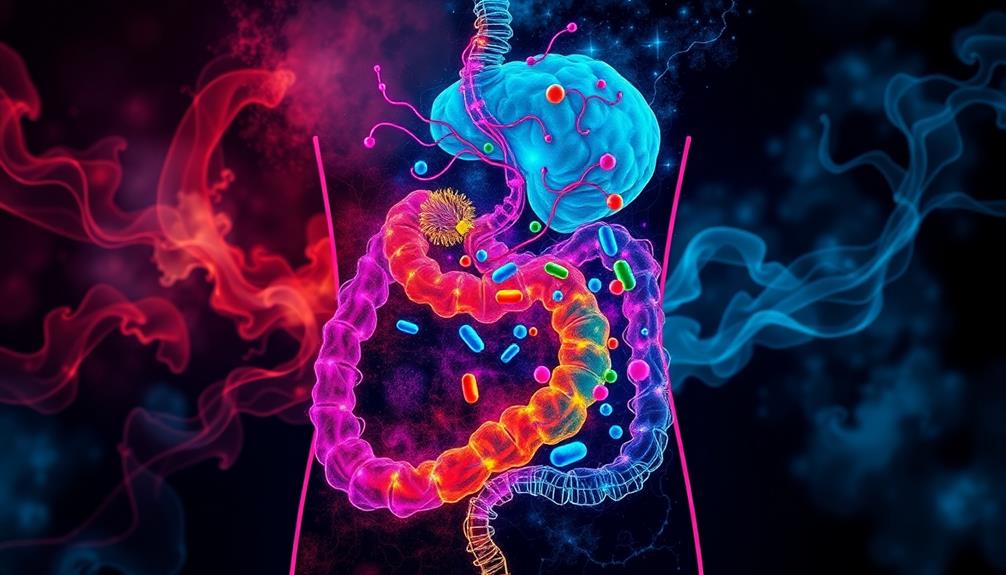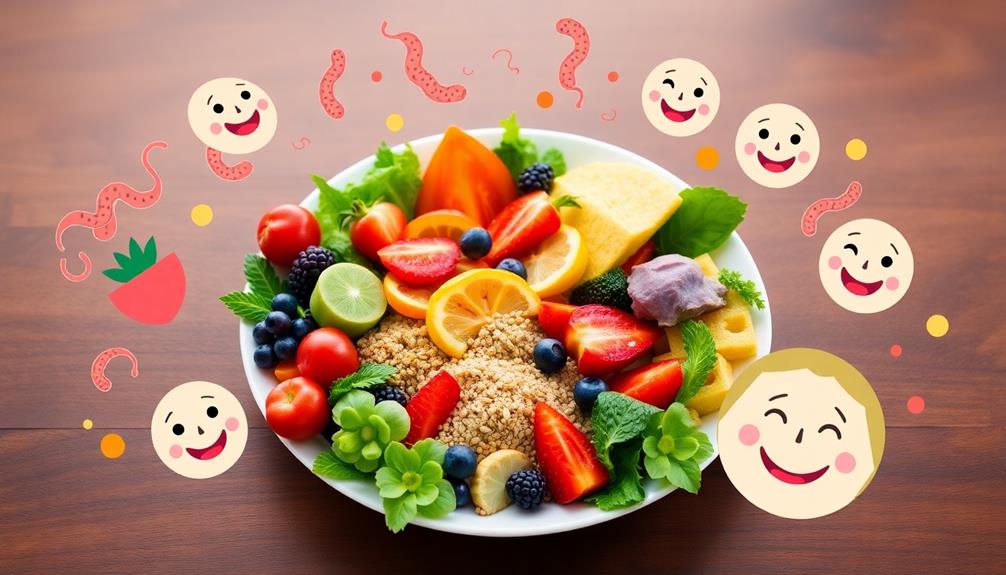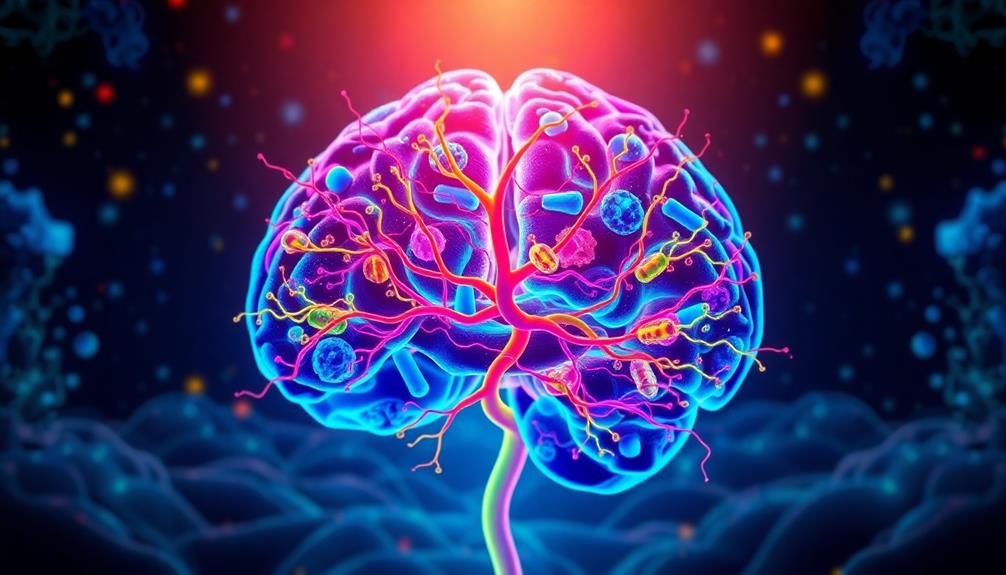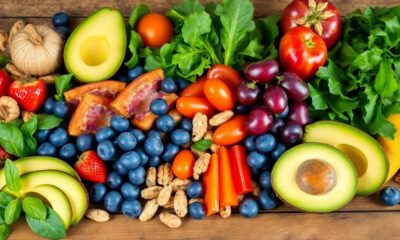General Health and Wellness
The Surprising Link Between Gut Bacteria and Mood
How does your gut bacteria influence your mood? Discover the surprising connection that could change how you feel every day!

Did you know your gut bacteria can affect your mood? It's true! Here's how your tummy and feelings are connected:
- Your gut makes over 90% of serotonin, a key mood booster.
- Healthy gut bacteria help keep anxiety and sadness in check.
- Foods like yogurt, bananas, and garlic can make your gut happier.
When your microbiome is balanced, you'll likely feel better and less stressed! So, next time you enjoy a tasty yogurt or a banana, remember it might brighten your day. Want to uncover more about this fascinating connection? There's so much more to discover!
Key Takeaways
- The gut microbiome produces over 90% of serotonin, a neurotransmitter crucial for mood regulation.
- Imbalances in gut bacteria can lead to increased anxiety and depression symptoms.
- Consuming fermented foods and prebiotics supports the growth of beneficial gut bacteria, enhancing mood.
- Regular physical activity positively influences gut health, reducing anxiety and depressive symptoms.
- Research shows a strong connection between a balanced microbiome and overall mental well-being.
Understanding the Gut-Brain Connection

When you think about your mood, you mightn't immediately consider your gut, but the connection between these two systems is profound. The gut microbiome, which is made up of trillions of tiny microorganisms, plays a big role in how you feel! It communicates with your brain through pathways like the vagus nerve.
Notably, the foods you eat can influence your gut health, and incorporating dishes like Mushroom Masala can provide beneficial nutrients for your gut bacteria.
Did you know that over 90% of serotonin, the happy chemical in your brain, is produced in your gut? That means your gut bacteria are essential for your emotional well-being. When your gut is healthy, it can help you feel happier and more balanced.
Research, especially from animal models, shows that if your gut bacteria aren't right, your mood can change. For instance, germ-free mice show more anxiety and less sociability.
But don't worry! Probiotics, like Lactobacillus rhamnosus, can help. These friendly bacteria have been linked to better mood and less anxiety in studies.
Mental Health and Gut Imbalance

An imbalance in gut bacteria can have a significant impact on your mental health. When your gut isn't healthy, it can lead to feelings of depression and anxiety. This is because certain bacteria, like *Eubacterium ventriosum*, are important for keeping your mood steady. If these bacteria decrease, you might feel down more often.
Additionally, incorporating nutrient-rich foods, such as those found in farm-to-table cooking, can support gut health and improve your overall mood. Did you know that over 90% of serotonin, a key hormone that helps with mood, is made in your gut? That's right! Your gut microbiota plays a big role in producing neurotransmitters that affect how you feel.
If your gut is inflamed, which can happen when the bacteria aren't balanced, it might lead to mood swings and symptoms that feel like depression or anxiety.
Here are some key points to remember:
- An unhealthy gut can lead to increased anxiety.
- Gut bacteria help produce important mood-regulating hormones.
- A balanced microbiome is key for mental well-being.
Strategies for Enhancing Gut Health

To enhance your gut health, focus on incorporating a variety of strategies that not only nourish your body but also support your mental well-being. A healthy gut can make a big difference in your mood!
Here are some fun ways to boost your gut microbiota:
1. Enjoy Fermented Foods: Add yogurt, kefir, and sauerkraut to your meals. These tasty treats are packed with beneficial gut bacteria that can lift your spirits!
You can also try traditional Indonesian desserts like Kue Putu to enjoy a sweet treat while supporting your gut health!
2. Choose Prebiotic Foods: Garlic, onions, and bananas help healthy gut bacteria grow. They're not just good for you—they're delicious too!
3. Stay Active: Regular physical activity isn't just great for your body; it can improve your gut health and reduce feelings of anxiety and depression.
Get moving with fun games or family walks!
4. Consider Probiotic Supplements: If you're looking for an extra boost, try probiotic supplements, especially those with Lactobacillus rhamnosus. They can help with mood and mental health.
If you also follow a Mediterranean diet filled with fiber and healthy fats, you'll be well on your way to a happy, healthy gut.
Enjoy your journey towards better gut health!
The Role of Diet in Mood

Diet plays an essential role in shaping your mood and emotional well-being. What you eat can really influence how you feel! A diet rich in fermented foods, like yogurt and kimchi, can boost the good bacteria in your gut. These probiotic bacteria help connect your gut and brain, which is important for your mental state.
Incorporating traditional Japanese dishes, such as Dorayaki (Red Bean Pancake), can also contribute to a balanced diet that supports mood enhancement. Here are some exciting ways your diet can help with mood:
- Fiber-Rich Foods: Eating whole grains and fruits can increase the production of short-chain fatty acids (SCFAs), which support mood regulation.
- Mediterranean Diet: This diet is packed with fibers and fermented foods, and studies show it's linked to better mood and less anxiety and depression.
- Stress Response: A healthy gut can help your body handle stress better, making you feel more balanced.
Choosing the right foods can be a fun way to improve your mental health! By making simple dietary interventions, you can help your gut microbiome thrive, leading to a happier, healthier you.
Future Directions in Research

Researchers are diving into the fascinating connection between gut bacteria and mood, aiming to uncover new insights that could transform mental health treatments. As they explore this exciting area, future research could lead to some great breakthroughs!
Here are a few directions scientists are heading in:
- Larger Studies: They're planning bigger, more rigorous human studies to validate how specific gut bacteria affect mental health, especially in cases of depression and anxiety. This is similar to how traditional Chinese dishes are carefully prepared to achieve specific flavors and health benefits.
- Gut-Brain Communication: Investigating how the gut and brain talk to each other, including the role of the vagus nerve, is essential for understanding the relationship between gut bacteria and our feelings.
- Psychobiotics: Clinical trials are underway to test psychobiotics, which could help ease symptoms of various mental health issues.
- Food Diets: Researchers are looking into fiber-rich and fermented food diets to see how they change our gut microbiome and improve mental health.
With these exciting advancements in probiotic research and diet, we're getting closer to understanding how our immune systems, food choices, and gut health can boost our mood!
Frequently Asked Questions
How Are Gut Bacteria Connected to Your Mood?
Your gut bacteria influence your mood by producing neurotransmitters, including serotonin. An imbalance can lead to increased anxiety or depression. Eating a fiber-rich diet and fermented foods can help maintain a healthy gut microbiome.
Is Gut Bacteria Linked to Mental Health?
Think of your gut as a bustling city; its bacteria influence your mental health. Yes, gut bacteria are linked to conditions like anxiety and depression, so nurturing them could brighten your mood and enhance well-being.
How Can Gut Bacteria Influence Behavior?
Gut bacteria influence your behavior by producing neurotransmitters and communicating with your brain. By maintaining a healthy microbiome through diet, like fiber and fermented foods, you can enhance emotional regulation and overall mental well-being. Additionally, research suggests that an imbalance in gut bacteria may even exacerbate symptoms of anxiety and depression, further highlighting the importance of gut health. On the other hand, the effects of food dyes on children have raised concerns regarding behavioral changes, such as increased hyperactivity. By prioritizing whole, nutrient-dense foods, you can support both gut-brain communication and overall mood stability.
What Have Scientists Discovered About the Relationship Between Gut Bacteria and Serotonin?
Imagine your gut as a bustling city, where friendly bacteria like *Lactobacillus* and *Bifidobacterium* generate serotonin. Scientists found that these bacteria directly impact serotonin levels, influencing your mood and emotional well-being considerably.
Conclusion
To sum up, taking care of your gut can bring joy to your mood! Just like how a superhero saves the day, a happy tummy can help you feel brighter and more cheerful. By eating yummy foods, staying active, and knowing how our gut works, you can boost your happiness. So, let's celebrate our gut health together! Remember, a happy gut leads to a happy heart, and that's something worth smiling about every day!
General Health and Wellness
How Cooking Techniques Evolved Throughout Human History
Get ready to explore the fascinating evolution of cooking techniques that transformed our meals—discover the delicious innovations that await!

Cooking techniques have taken an exciting journey through history! You started with fire, which made food tastier and safer. As time moved on, you discovered boiling and stewing with pots, and even advanced to baking bread! Cultural exchanges influenced your culinary creations, mixing flavors from around the world. In the Americas, you combined Indigenous and European recipes for delicious new dishes. Today, smart appliances and food technology make cooking easier and more fun for everyone. Imagine all the tasty meals you can create! If you're curious to learn more about these amazing cooking changes, just wait—you'll be inspired!
Key Takeaways
- The discovery of fire for cooking marked a pivotal moment, enhancing food safety and flavor for early humans.
- The introduction of earthenware pots around 6000 B.C. allowed for boiling and stewing, expanding cooking techniques.
- Preservation methods like smoking, salting, and fermentation developed to secure food availability and enhance flavors.
- Agricultural innovations, including crop cultivation and livestock domestication, transformed food production and culinary practices.
- Cultural exchanges and regional ingredients influenced the fusion of culinary traditions, leading to diverse global cuisines.
Origins of Cooking

Cooking has transformed human diets and cultures since its inception. Imagine early humans discovering the joys of cooked food! They probably stumbled upon the delicious taste of meat that had been cooked by forest fires. This tasty treat led them to intentionally use fire for cooking, marking one of the first cooking techniques.
As they explored new methods, they might've also discovered the rich flavors of ingredients like cassava and seafood, which later became staples in various cuisines, including Brazilian seafood dishes.
The Aurignacian people of southern France took things a step further by steaming food over hot embers. Can you picture the excitement of enjoying steamed meals? Around 30,000 years ago, the first bread was made from a simple mix of cracked wild grains and water, toasted on hot stones. How cool is that?
With the invention of earthenware pots, cooking methods improved even more. You could now boil, stew, and braise food, making meals more flavorful and satisfying.
Plus, as people started to domesticate livestock and grow plants, cooking practices expanded, offering a wider variety of options for everyone's plate.
These early steps in the origins of cooking paved the way for the culinary traditions we cherish today. So, next time you enjoy a warm meal, remember the amazing journey cooking has taken throughout history!
Development of Culinary Techniques

Throughout history, advancements in culinary techniques have shaped how we enjoy food today. Imagine life without delicious stews or freshly baked bread! The introduction of earthenware pots around 6000 B.C. made it possible to boil and stew food, greatly improving our cooking methods. Isn't it amazing how this changed everything?
As people began to domesticate livestock and cultivate plants, they created a stable food supply. This led to new culinary techniques like braising and roasting, which made our meals even tastier. For instance, traditional dishes like Muamba De Galinha showcase how ingredients and cooking methods evolved within cultures, enriching the culinary landscape.
To keep food fresh and tasty, ancient cooks developed preservation methods, such as smoking, salting, and air-drying. These techniques guaranteed that families had food to eat throughout the year.
One of the most exciting developments came around 4000 B.C. when the Egyptians used yeast in bread-making. This breakthrough allowed bakers to create lighter, fluffier bread, making every meal feel like a celebration!
With the shift from open flames to controlled cooking methods using pots, cooks could explore complex flavors and dishes. Each of these culinary techniques has brought us closer to the joyful meals we share today, making every bite a delightful experience!
Agricultural Innovations

Advancements in culinary techniques were closely tied to innovations in agriculture, which transformed how societies produced food. Around 9000 B.C. in the Fertile Crescent, people shifted from gathering to cultivating crops. This change created stable food supplies, making it easier to enjoy meals together, such as flavorful dishes like Mushroom Masala that highlight the use of rich spices and fresh ingredients.
Here are some key agricultural innovations that helped in preparing food:
- Domestication of Livestock: Around 6000 B.C., animals like cattle provided not just meat but also labor and manure to enrich the soil. This made farming even more productive!
- The Invention of the Plow: Around 3550 B.C., the plow revolutionized farming by making soil cultivation quicker and easier. Farmers could grow more food to share with their families.
- Diversified Crops: By 3000 B.C., farmers in Mesopotamia grew various crops, boosting food availability and nutrition.
- Irrigation Techniques: Egyptians developed irrigation around 5000 B.C., allowing controlled water distribution, which helped crops flourish even in dry areas.
These agricultural innovations laid the groundwork for preparing delicious meals and brought families together around the table, celebrating the joys of food!
Key Historical Milestones

Let's take a closer look at some key milestones in cooking history!
From the domestication of livestock to the clever ways of preserving food, these innovations have shaped what we eat today.
The evolution of cooking techniques can also be seen in the development of dishes like Red-Braised Pork Belly, which highlights the art of slow braising and flavor enhancement.
You'll see how these exciting developments made cooking not just a necessity, but a joyful part of our lives!
Domestication of Livestock
Domestication of livestock marks a pivotal shift in human history, fundamentally changing how societies interacted with their environment. Around 9000 B.C., people in the Fertile Crescent began domesticating sheep. This early livestock helped produce wool and provided tasty meat!
Fast forward to 6000 B.C., and cattle became an important part of agricultural life, boosting food supply stability. The introduction of domesticated animals also allowed for the development of various culinary traditions, including the art of making traditional stuffed pasta from local ingredients.
By 7000 B.C., Mesoamerican societies were domesticating turkeys, giving families a reliable source of protein for their meals. Then, around 5000 B.C., pigs joined the mix! These clever animals could eat leftovers, making them a versatile food source.
With the domestication of livestock, cooking and food preservation techniques blossomed. Communities shifted from foraging for food to enjoying delicious meals made from their own animals. This change led to exciting new recipes and culinary traditions that brought families together.
Agricultural Innovations Timeline
With the domestication of livestock paving the way for agricultural practices, societies began to explore innovative methods to enhance food production. Around 9000 B.C., in the Fertile Crescent, people started cultivating plants, marking a big change from foraging to farming.
They domesticated sheep, which helped them grow food more reliably. This period also saw the beginnings of sustainable practices, as communities learned to utilize seasonal ingredients, similar to modern farm-to-table cooking.
By 6000 B.C., the domestication of cattle was another key agricultural innovation, letting them produce even more food.
In 5000 B.C., the Egyptians took a giant leap forward by inventing irrigation techniques. This amazing advancement helped them water their crops more efficiently, leading to better harvests.
Then, around 4000 B.C., they discovered the magic of yeast in bread-making, which allowed them to create delicious leavened bread. Yum!
Preservation Methods Development
Evolving from basic survival needs, ancient civilizations developed a variety of preservation methods to extend the shelf life of food. You see, preserving food was essential for survival, and early techniques like drying and salting made a big difference!
Ancient cultures also discovered smoking, which not only added flavor but helped keep meats and fish fresh for longer. Additionally, fermentation played a significant role in various cuisines, such as the production of sweet red bean paste in Japanese desserts like dorayaki.
Another exciting method, fermentation, was used by the ancient Egyptians around 3500 B.C. They made beer and sourdough bread, showing how creative they could be! Fast forward to ancient Rome, where folks got clever with ice and chilling techniques. They used snow from mountains to cool their food and drinks, giving a taste of early refrigeration.
By the Middle Ages, people really stepped up their game. They began using sugar to preserve fruits, which led to sweet treats we still enjoy today. Plus, pickling became popular, laying the groundwork for modern food preservation techniques.
Thanks to these innovative methods, we can enjoy a wide variety of delicious foods today! So next time you savor a pickled cucumber or a sweet jam, remember those ancient pioneers who helped preserve our food!
Cultural Influences on Cooking

Cooking is all about the ingredients you have and the people around you!
When different cultures meet, they mix their favorite flavors and traditions, creating delicious dishes that tell a story.
For example, Indonesian cuisine showcases this beautifully, with dishes like Kue Putu and Dadar Gulung that highlight local ingredients and unique cooking techniques.
Regional Ingredients Impact
Regional ingredients play an essential role in shaping culinary practices around the world. These ingredients give each culture its unique flavor and style.
For example, in ancient China, the introduction of soybeans led to delicious dishes and preservation methods that are still loved today. Isn't it fascinating how something so simple can create such variety?
In Mesoamerica, staples like maize not only nourish but also inspire iconic dishes like Chilaquiles, which reflect the ingenious use of leftover ingredients.
In the Fertile Crescent, about 9000 B.C., farming changed everything. With crops and animals domesticated, people could boil, stew, and cook in ways they never imagined before. This allowed them to enjoy hearty meals packed with flavor!
Mesoamerica also shines with its regional ingredients. Maize, beans, and avocados form the foundation of tasty recipes that have been passed down through generations. You can almost taste the history in every bite!
Lastly, think about Latin America, where European, African, and Indigenous flavors blend together. This mix shows just how important regional ingredients are in creating diverse culinary practices.
Fusion of Culinary Traditions
Culinary fusion thrives on the rich tapestry of cultural exchanges, where diverse traditions collide and create something entirely new. You can see this in the exciting world of food today! When people migrate and trade, they bring their special ingredients and cooking methods.
Just think of Asian fusion, where Eastern flavors mix beautifully with Western techniques. In Ethiopian cuisine, for example, the unique blend of flavors and communal eating style reflects centuries of cultural influences, showcasing dishes like Tej (Honey Wine) that are integral to celebrations.
In Latin America, European, African, and Indigenous influences come together to create a vibrant array of dishes that tell a story of shared history. The Silk Road played a huge role, too, as it connected East and West, allowing spices and cooking styles to travel far and wide.
Colonialism also shaped modern American cuisine, as settlers adapted Indigenous ingredients and recipes, blending them into something unique.
Nowadays, with globalization, chefs around the world are experimenting and having fun! They're mixing and matching flavors from different cultures, showing just how much effort has been made to create delightful hybrid dishes.
Historical Perspectives on Cooking

Throughout history, humanity's relationship with food has evolved dramatically, reflecting both innovation and survival instincts. You might be surprised to learn that the first known cooking techniques involved using open flames to prepare meat. Imagine those early humans, discovering fire after forest fires, and realizing it could help them survive!
As time went on, the Aurignacian people in southern France took things up a notch by steaming food over hot embers. This showed early innovation in cooking.
Around 6000 B.C., the introduction of earthenware allowed people to boil and stew their food, making meals tastier and more nutritious, especially as agriculture developed.
By 4000 B.C. in Egypt, the use of yeast as a leavening agent in bread-making brought delightful changes to baked goods, adding flavor and texture. The evolution of these cooking techniques gives us fascinating insights into the cooking practices of our ancestors.
Each advancement marked a shift from nomadic lifestyles to settled agricultural communities, enhancing how families prepared and enjoyed meals together.
American Culinary Evolution

Blending diverse cooking traditions, American culinary evolution reflects a rich tapestry woven from the methods of European settlers and the ingredients of indigenous peoples. You can see this fusion in the delicious American food we enjoy today.
Early Native American diets featured maize, beans, and squash, all grown with care. They used clever cooking techniques like roasting and boiling, which settlers later adopted.
As settlers brought in European livestock and crops, they created new dishes like cornbread and succotash. The westward expansion in the 19th century added even more flavors, as different regions developed distinct cuisines based on local ingredients and immigrant traditions.
Thanks to technological advancements, like the railroads in the 1800s, food distribution transformed. This made it easier for cities to connect with rural farms, leading to sophisticated cooking practices that mixed old and new methods.
Today, American culinary evolution is a celebration of flavors, cultures, and creativity. Whether you're enjoying a backyard barbecue or a cozy family dinner, every bite tells a story of how our food has grown and changed.
Traditional and Modern Baking

American cuisine's evolution naturally leads us to explore the art of baking, a fundamental aspect of cooking that has transformed over the centuries.
In the past, traditional baking meant using Dutch or brick ovens, which took a lot of time and effort to prepare. Imagine waiting for two hours just to get the perfect temperature!
Back then, making bread involved lots of kneading, but with the invention of commercial yeast, that process became much quicker and easier.
Today, modern baking has embraced convenience. You can whip up a delicious cornmeal bread using an 8 x 8 square pan! Just preheat your oven to 450°F, and you're ready to go.
Colonial recipes for cornmeal bread called for butter, milk, and yeast, with a dough rise time of an hour.
Now, you'll notice that many contemporary recipes simplify these steps, often using fewer ingredients and quicker methods.
Advancements in Food Technology

Revolutionizing how we prepare and preserve food, advancements in food technology have reshaped our culinary landscape. These innovations make cooking more enjoyable and accessible for everyone. You can now savor delicious meals at home with the help of modern techniques and tools!
Here's a snapshot of some exciting advancements in food technology:
| Technology | Benefits | Examples |
|---|---|---|
| Pasteurization | Extends shelf life, enhances safety | Milk, juices |
| Vacuum Sealing | Preserves quality during transport | Meats, veggies |
| Freeze-Drying | Retains nutrients and flavors | Fruits, soups |
| High-Pressure Processing | Extends shelf life while keeping taste | Packaged meals |
With advancements in food technology, even oven baking has become easier. You can use sous vide machines or smart thermometers to cook like a pro! These tools help you achieve perfectly cooked meals to impress your family and friends.
Plus, enriched foods and tasty meat alternatives cater to everyone's dietary needs. So, gather your loved ones, whip up something special, and enjoy the delicious results of these amazing advancements in food technology!
Smart Cooking Devices

Smart cooking devices have transformed the way you prepare meals, making it easier than ever to achieve professional results at home. With gadgets like the CHEF iQ Smart Cooker, you can streamline your cooking process and enhance the nutritional value of your meals.
Here's how these devices can help you whip up delicious recipes today:
- Smart Thermometers: These nifty tools give you precise temperature control, ensuring your meat is perfectly cooked every time. Say goodbye to undercooked chicken!
- Sous Vide Machines: You can achieve restaurant-quality results right in your kitchen. Just set the temperature and let it do the magic!
- Immersion Blenders: Need to puree soup or make a sauce? This handy device makes it super simple, turning you into a gourmet chef in no time.
- Evolving Technology: As kitchen gadgets get smarter, they reflect our demand for convenience and efficiency, making cooking fun for everyone!
With these amazing smart cooking devices, you'll feel like a culinary superstar, ready to impress family and friends at every meal!
Enjoy exploring new recipes and creating tasty dishes together!
Frequently Asked Questions
How Did Humans Evolve to Cook Food?
You evolved to cook food by discovering fire's benefits. Initially, you stumbled upon cooked meat from wildfires, then learned to harness fire, leading to safer, tastier meals that improved your health and survival.
What Are the Changes in Cooking Practices Over Time?
You'd think cooking's just about throwing ingredients together, but over time, it's transformed from simple flame roasting to high-tech sous vide. Surprisingly, efficiency and gourmet techniques now make you a master chef in your own kitchen!
What Is the Origin and Evolution of Cooking?
Cooking originated when early humans accidentally discovered fire and its ability to transform food. Over time, you'll see techniques evolve, from steaming with embers to boiling and baking, shaping culinary practices into what they are today.
What Is the Difference Between Cooking in the Past and Present?
Cooking today's more diverse and efficient than in the past. You've got advanced techniques, access to global ingredients year-round, and modern preservation methods, making meal prep easier and safer, fitting your fast-paced lifestyle perfectly.
Conclusion
Cooking has come a long way, turning simple ingredients into delightful feasts that bring us together. From our early ancestors mastering fire to today's smart gadgets, each step has added a sprinkle of magic to our kitchens. As you whip up your next meal, remember, every dish carries a piece of history and a dash of love. So, let's keep stirring the pot of creativity and flavor, and enjoy the tasty journey ahead with family and friends!
General Health and Wellness
Why Some Foods Taste Better When You’re Drunk
Often, the magic of alcohol enhances food flavors, but what truly drives this delicious phenomenon? Discover the surprising reasons behind it!

When you're enjoying drinks, food can taste extra amazing thanks to a few fun reasons! First, alcohol makes flavors more intense, turning simple snacks into tasty treats. You might also feel hungrier because alcohol can increase your cravings for comfort foods. Plus, those happy vibes from being with friends make everything more delicious. Social settings, like parties, make you want to share and try new foods, while laughter adds to the fun. Just remember, while it's exciting to enjoy treats, it's good to know how late-night eating can affect your health. Stick around, and you'll discover even more about these tasty changes!
Key Takeaways
- Alcohol enhances sensory perception, making flavors more vivid and enjoyable while eating.
- Hormonal changes from alcohol increase cravings for high-calorie comfort foods, leading to indulgence.
- Social interactions and positive emotions while drinking amplify the enjoyment of shared meals.
- Alcohol disrupts appetite regulation, causing overeating and cravings for unhealthy late-night snacks.
- The communal atmosphere of drinking environments encourages trying new foods and flavors, enhancing the overall experience.
Alcohol's Effect on Taste

When you sip on a drink, it can greatly alter how you experience flavors in food. That's right! Alcohol has a special way of enhancing your taste buds. When you enjoy a glass of wine or a cold beer, you might notice that food tastes so much better.
For example, dishes like Red-Braised Pork Belly can become even more delightful with a drink in hand. Studies show that alcohol boosts your brain's reaction to food smells, making everything smell and taste more delightful!
Here's how it works:
- Aperitif Effect: Alcohol makes your senses more alive, which means flavors pop! You may find that even simple snacks taste gourmet.
- Opiate System Activation: When you drink, your brain releases feel-good chemicals. This makes foods that usually don't excite you seem super tasty!
- Texture and Taste Changes: Alcohol helps your brain process how food feels and tastes, turning ordinary bites into something special.
Increased Food Cravings

When you're enjoying a drink, your body goes through some fun changes that can crank up your appetite!
This is why you might find yourself craving salty snacks or a cheesy slice of pizza, especially when you're out with friends.
The allure of festive treats like Graveyard Taco Dip can make these cravings feel even stronger in social settings, making those tasty treats even harder to resist!
Hormonal Changes Influence Appetite
Alcohol not only alters your mood but also wreaks havoc on your appetite regulation. When you drink, your body sends mixed signals about hunger. This happens because alcohol messes with hormones like leptin, which normally tells you when you're full. Instead, you might find yourself craving more and more food, even if you're not really hungry!
This heightened craving can lead you to seek out satisfying comfort foods, like the rich flavors of traditional dishes such as Caldeirada or Caruru, which can feel even more appealing under the influence.
Here are some key points about how alcohol influences your appetite:
- Alcohol suppresses leptin, leading to increased cravings for food.
- The release of AgRP makes you feel hungrier than usual.
- Many people want unhealthy, high-calorie foods when drinking.
These hormonal changes can trick you into thinking you need to eat more. You might notice that your taste buds get excited about greasy fries or cheesy snacks, making them seem extra delicious!
Understanding how alcohol affects your appetite can help you make better choices. Next time you're out, try to recognize those false hunger signals. You can still enjoy tasty treats, but being aware of your cravings can help you find a balance. Eating mindfully can make your experiences even more enjoyable!
Social Settings Amplify Cravings
Social settings can really amplify your cravings, especially after a few drinks. You might notice that alcohol makes food taste so good! When you're out with friends, having fun, your inhibitions relax, and you feel more open to indulging.
It's like a magic switch flips in your brain, making those tasty snacks even more tempting. For instance, dishes like Chilaquiles or elote are often more appealing in a lively atmosphere, where the combination of flavors and textures can be heightened by the festive mood.
Here are some fun facts about how social settings change our food cravings:
- Studies show that men eat about 30% more food when they're drinking compared to when they're sober. Wow!
- The mix of drinks and good company makes flavors pop, especially in salty and fatty foods.
- Late-night food binges are common, with everyone reaching for greasy, high-calorie treats.
- Emotional states and friends' choices can lead you to pick comfort foods, making it even easier to indulge.
Psychological Influences of Alcohol

Many people find that their food preferences shift dramatically after a few drinks, primarily due to the psychological effects of alcohol. When you drink alcohol, it relaxes your inhibitions, making food more enjoyable and social moments even sweeter.
Suddenly, those late-night greasy fries or cheesy nachos seem like the best choice ever! This is particularly true for comfort foods like satisfying fried pork chops, which are known for their crispy texture and rich flavor, often enhancing the experience of indulgence.
Here are a few reasons why this happens:
- Emotional Boost: Alcohol can amplify your feelings, leading you to crave comfort foods that remind you of happy times.
- Risky Choices: With lowered inhibitions, you're more likely to try foods you might usually skip, like that tempting, gooey slice of pizza.
- Peer Influence: When you're out with friends, you might indulge in tasty treats simply because everyone else is!
Role of Social Settings

When you're out with friends, the food you enjoy can taste even better! The fun atmosphere and laughter make everything from cheesy fries to pizza feel like a real treat.
Sharing dishes like Mushroom Masala or Gobi Manchurian can create a sense of camaraderie, as everyone dives into the flavorful experience together.
Plus, seeing your pals munching on those tasty bites might just inspire you to try something new and delicious!
Enhanced Sensory Experience
Gathering with friends often transforms the dining experience, making food taste remarkably better. When you're with others, the laughter and chatter create a joyful atmosphere. Plus, a little alcohol can help you relax and enjoy every bite even more! This is especially true when indulging in delightful snacks like Dorayaki (Red Bean Pancake), which can be even more enjoyable in a social setting.
Here's why the enhanced sensory experience makes food taste fantastic in social settings:
- Heightened flavors: Alcohol can boost your taste buds, making even simple snacks burst with flavor.
- Comfort and fun: Being around friends makes you feel good, and that happiness adds to your enjoyment of food.
- Shared experiences: Eating together creates memories, and those moments can make every dish taste sweeter.
When you enjoy food with friends, everything feels more delicious. The sounds, sights, and smells of a lively gathering turn an ordinary meal into a celebration.
Research even shows that cravings for tasty treats grow stronger in social settings, especially for those late-night munchies. So, the next time you're out with friends, remember that the right company can turn any meal into a delightful feast!
Peer Influence on Choices
The influence of your friends on food choices becomes even more pronounced in social settings like bars and parties.
When you're surrounded by friends, it's easy to get caught up in the fun and excitement. Peer influence plays a big role in what you decide to eat. You might find yourself sharing delicious high-calorie snacks that you wouldn't normally choose, like loaded baked potatoes, which are a classic comfort food often enjoyed in group settings.
Here are some reasons why food tastes better in these social situations:
- Indulgence: Alcohol can relax your inhibitions, making you more open to trying those tasty, indulgent options.
- Group Dynamics: Eating together creates a sense of enjoyment. Laughter and shared experiences can make everything taste even better!
- Comfort Foods: You're likely to crave comforting, familiar foods when you're out with friends, adding to the pleasure of the meal.
- Late-Night Rituals: Many cultures have fun late-night eating traditions, making sharing food feel like a celebration.
Cultural Eating Norms
Cultural eating norms are heavily shaped by social settings, especially in environments like bars and parties where drinking is common. When you're out with friends, the urge to eat often rises alongside the drinks.
You might notice that late-night cravings for tasty treats like pizza and burritos become hard to resist. This happens because alcohol makes food taste even better, and it's a fun way to enjoy time with others! For instance, themed snacks like Graveyard Taco Dip can add a festive twist to the experience.
- Alcohol can lower your inhibitions, making you more open to indulging in comfort foods.
- The communal atmosphere encourages sharing and trying new flavors, enhancing the overall experience.
- Late-night munchies are a shared cultural moment, making food a big part of social gatherings.
Hormonal Changes and Appetite

Alcohol's impact on your body's hormones can considerably alter your appetite, often leading to unexpected cravings and overeating. When you sip a drink, your body changes in ways that make you feel hungrier. First, alcohol suppresses leptin, the hormone that tells you when you're full. This means you mightn't feel satisfied even after eating.
Additionally, the combination of alcohol and traditional Ethiopian dishes, like Yekolo (Roasted Barley), can enhance those cravings, as their unique flavors and textures become even more appealing.
- Alcohol also stimulates the neuropeptide AgRP, which sends strong hunger signals, even if you're not really hungry.
- These hormonal changes can throw your appetite out of balance, making you crave high-calorie and unhealthy foods.
- Plus, when you drink, your body releases more opioids, which can make food taste even better!
These changes can lead to a fun but sometimes overwhelming food experience. You might find yourself reaching for those tasty snacks or ordering that extra pizza slice without thinking twice.
Cultural Eating Behaviors

When you're out with friends and drinks are flowing, the urge to snack often kicks in, influenced by social norms and collective behaviors surrounding eating and drinking.
It's not just about the food; it's about the fun and the laughter shared around it! Late-night food cravings make us feel excited and connected, especially when we indulge in those cheesy, greasy delights.
Here are a few reasons why cultural eating behaviors play a big role:
- Comfort Foods: Foods like pizza and burritos remind us of good times, making them taste so much better after a few drinks.
- Social Acceptability: Eating while drinking is seen as fun and normal, making it easier to enjoy that late-night snack without guilt.
- Shared Experiences: Everyone can relate to those "drunk munchies," creating a bond that makes the food even more enjoyable.
Health Implications of Late-Night Eating

Indulging in late-night eating while under the influence can have significant health implications. You might enjoy those cheesy fries or slices of pizza, but those high-calorie options can sneak up on you. Over time, they can lead to weight gain and other health issues.
Here's a quick look at some health implications of late-night eating:
| Health Concern | Description | Long-Term Effects |
|---|---|---|
| Excessive Caloric Intake | Late-night snacks often pack extra calories. | Weight gain, obesity risk |
| Hangover Symptoms | Unhealthy foods can worsen hangovers. | Increased discomfort the next day |
| Hormonal Imbalances | Alcohol can disrupt your appetite regulation. | Overeating even when not hungry |
| Unhealthy Eating Patterns | Regular late-night eating can form bad habits. | Metabolic issues and related health risks |
Being aware of these health implications helps you make better choices. Next time you're tempted, think about how those late-night snacks could affect your health. Enjoy the fun, but keep your body in mind!
Frequently Asked Questions
Why Does Food Taste Better When I'm Drunk?
When you drink, your senses heighten, making flavors more intense. Alcohol lowers your inhibitions, allowing you to enjoy simple foods more. You might crave rich, indulgent options, enhancing your overall eating experience.
Does Alcohol Affect the Taste of Food?
Yes, alcohol definitely affects the taste of food. It heightens your sensitivity to flavors and aromas, making even simple dishes feel gourmet, while also altering your perception of food quality and enjoyment.
Does Food Taste Better Sober?
Yes, food often tastes better when you're sober. Your senses are sharper, allowing you to appreciate complex flavors and textures. You're more likely to choose nutritious options, enhancing your overall eating experience and enjoyment.
Does Alcohol Add Flavor to Food?
Did you know that 70% of people believe alcohol enhances their meals? It doesn't exactly add flavor, but it amplifies your taste experience, making each bite feel richer and more satisfying. Enjoy those flavors!
Conclusion
So, next time you're enjoying a fun night out, remember: some foods just taste better when you've got a little buzz! Did you know that about 40% of people say they crave snacks more after having a drink? That's a lot of hungry folks! Whether it's cheesy nachos or sweet fries, the magic of alcohol makes those flavors pop. So, grab a bite, share some laughs, and enjoy those tasty treats with friends!
General Health and Wellness
The Psychology of Food Aversions and Phobias
Psychological factors behind food aversions and phobias can deeply impact mealtime experiences; uncover the surprising connections that may change your relationship with food forever.

Food aversions and phobias can make meals tricky, especially when certain smells or tastes bring back bad memories. You might avoid foods because of their texture or a past experience, like being sick after eating something. Here are some key points to know:
- Aversions often arise from sensory experiences.
- Emotional connections play a big role.
- Allergies can lead to avoidance, too.
- Support from friends and experts can help!
By exploring these feelings and trying new strategies, you can make mealtime happier and healthier. Stick around, and you'll discover more ways to tackle these challenges!
Key Takeaways
- Food aversions often stem from negative associations or traumatic experiences related to specific foods, impacting psychological well-being.
- Sensory processing differences can heighten food aversions, especially in individuals with Autism Spectrum Disorder, making certain textures or smells intolerable.
- Emotional states, such as stress and anxiety, can exacerbate food aversions, reducing enjoyment and influencing meal choices.
- Hormonal changes, particularly during pregnancy, can lead to increased sensitivity and altered food preferences, affecting overall eating behavior.
- Support from healthcare professionals, including therapists and nutritionists, is crucial for managing food aversions and maintaining balanced nutrition.
Definition of Food Aversions

Food aversions are intense dislikes that can make you shun specific foods, often leading to a strong desire to avoid them completely. Imagine biting into a food you once loved, only to feel a wave of nausea wash over you! This can happen suddenly, and it's not just you; many people experience food aversions.
In fact, certain cultural dishes, like Red-Braised Pork Belly, can evoke strong reactions based on individual experiences and memories associated with them.
Here are some key points about food aversions:
- Sensory Experiences: These aversions often arise from how food looks, smells, or feels. One bad experience can change your taste forever!
- Psychological Factors: Sometimes, anxiety or negative memories linked to certain foods can make you feel uneasy around them.
- Eating Behaviors: Food aversions are different from just being picky; they can cause real distress and may even affect your social life.
- Nutritional Deficiencies: If you avoid too many foods, it might lead to missing out on important nutrients.
- Professional Intervention: If your food aversions become overwhelming, chatting with a health expert can help you find solutions.
It's fascinating how our minds and bodies work together when it comes to what we eat!
Causes of Food Aversions

A variety of factors can lead to the development of food aversions, often intertwined with our survival instincts. You might find that food aversions help you avoid harmful or toxic foods that could make you sick.
For instance, certain textures or flavors in foods like Mushroom Masala might trigger a negative response if a bad experience is associated with them. These aversions can pop up quickly and even spread to similar foods. For example, if you have a bad experience with one food, you might steer clear of others that look or taste alike!
Hormonal changes, especially during pregnancy, can also play a role. When expectant mothers experience increased GDF15 hormone levels, it can lead to food aversions as a protective measure.
Additionally, sensory processing differences, like being extra sensitive to taste or smell, can heighten food aversions, particularly for those with Autism Spectrum Disorder (ASD).
Psychological factors, such as stress or trauma, can make food aversions worse, leading to less joy in eating. Sometimes, these aversions might even contribute to restrictive food intake disorders, where you limit your food choices.
Understanding these causes can help you navigate your relationship with food, making mealtime a happier experience for all!
Mental Health Connections

Food aversions can sometimes be linked to how you feel emotionally, like when stress or sadness makes certain foods seem less appealing.
For example, traditional dishes such as Muamba De Galinha may lose their allure during tough times, reflecting how personal feelings can impact food preferences.
If you've ever noticed that a favorite snack doesn't taste as good when you're feeling down, you're not alone!
Understanding these feelings and how your senses react can help you enjoy food again and create a happier relationship with what you eat.
Emotional Triggers and Responses
Emotional triggers like stress, grief, or trauma can greatly amplify food aversions, especially for those already grappling with mental health issues. When you experience strong emotions, they can make certain foods seem less appealing, even in the context of comforting dishes like traditional Brazilian cuisine.
This is especially true if you have anxiety disorders. You might find that certain textures or tastes become overwhelming, leading to more food aversions.
Negative experiences, like getting sick after eating something, can create learned taste aversions, where your mind connects that food with a bad memory. If you've ever felt anxious about trying new foods, you're not alone!
Mood disorders, like depression, can also affect how you enjoy food. You mightn't feel excited about meals anymore, which can lead to a dislike for certain dishes.
Here are some key points to remember:
- Emotional triggers can worsen food aversions.
- Anxiety disorders make you sensitive to food textures.
- Negative experiences can cause learned taste aversions.
- Mood disorders reduce enjoyment of food.
Understanding these connections can help you navigate your feelings about food and find joy in mealtime again. Remember, it's okay to seek support!
Sensory Processing Challenges
Many people struggling with food aversions also face sensory processing challenges that heighten their sensitivity to taste, smell, and texture. This means certain foods can feel overwhelming or even scary!
For many, especially those with Autism Spectrum Disorder, sensory processing makes the world a bit more intense. You might find yourself avoiding certain foods due to food neophobia—fear of new foods. Exploring flavors from diverse cuisines, such as Indonesian sweets like Kue Putu or Dadar Gulung, can sometimes help ease the fear of trying new textures and tastes.
Here are some important points to reflect on:
- Heightened Sensitivity: Strong tastes or unusual textures can lead to food aversions and selective eating.
- Impact on Kids: Research shows about 70% of children with sensory processing issues have food aversions.
- Therapeutic Interventions: These can help! Gradually introducing new foods can make them less scary and more enjoyable.
Addressing sensory processing challenges can open up a world of delicious options. With the right support, you can explore new dietary preferences without fear.
Impact of Food Allergies

Experiencing food allergies can markedly shape your relationship with food, often leading to strong aversions to specific items. When you have a food allergy, you might avoid certain foods to dodge discomfort or allergic reactions. This protective instinct can sometimes lead to nutritional deficiencies, which isn't fun!
It's important to find alternatives that still allow you to enjoy the flavors and textures you love, like a warming Nettle and Potato Soup that's both nutritious and safe for many.
Did you know about 8% of children and 4% of adults have food allergies? Common culprits include dairy, eggs, peanuts, tree nuts, soy, and wheat. If you have multiple allergies, you might face an even bigger challenge, as this can increase food neophobia—the fear of trying new foods.
To keep enjoying meals, it's important to work with healthcare providers who can help you understand your triggers. Together, you can create a plan for balanced nutrition, ensuring you get all the nutrients you need. Remember, it's possible to find delicious alternatives that keep you safe and satisfied!
Here are a few tips to navigate food allergies:
- Always read ingredient labels.
- Ask about allergens when dining out.
- Experiment with allergy-friendly recipes.
With a little creativity, you can still enjoy tasty meals while staying safe!
Symptoms and Triggers

When it comes to food aversions, your feelings can really take center stage!
You might notice that certain smells or tastes trigger strong reactions, like feeling sick or even gagging, and this can make mealtime a bit tricky.
For instance, someone might've a strong aversion to dishes like Umeboshi due to their tart flavor.
Plus, things like hormones or past experiences can play a big role in what foods you avoid, making it important to understand these symptoms and triggers together!
Emotional Responses to Foods
Food aversions can trigger intense emotional responses that go beyond mere dislike. When you encounter certain foods, you might feel a wave of nausea, anxiety, or even distress. These feelings often stem from the sensory characteristics of the food, like its taste, smell, or texture.
For instance, the unique flavors in traditional Ethiopian dishes, such as Tej (Honey Wine), can be polarizing and evoke strong reactions in some individuals. If you've ever had a negative experience related to a specific dish, you might find yourself gagging or feeling upset just at the thought of it.
Psychological factors play a big role, too! Stress, trauma, and mood disorders can heighten sensitivity to certain foods, making reactions stronger.
For kids, especially those with Autism Spectrum Disorder, the emotional responses can become even more intense. You might see crying or tantrums when they face their aversive foods, showcasing how deeply rooted these food-related feelings can be.
Understanding these emotional responses helps you recognize that it's more than just picky eating. It's about comfort, safety, and past experiences.
Common Sensory Triggers
Identifying common sensory triggers can greatly enhance your understanding of food aversions. These triggers can create emotional reactions that might make mealtime a bit tricky. For instance, the texture of certain foods, like the creamy crema used in traditional dishes such as Chilaquiles, can evoke strong feelings of discomfort.
You might notice that certain smells, tastes, or textures can evoke strong feelings, like nausea or even gagging. Here are three common sensory triggers you might encounter:
- Strong Smells: Foods with powerful aromas can be overwhelming, leading to avoidance.
- Unpleasant Textures: Foods that are slimy, gritty, or mushy can make you feel uncomfortable and lead to food aversions.
- Intense Tastes: Spicy or bitter flavors can trigger negative experiences, making it harder to accept certain foods.
If you find yourself feeling anxious during mealtime, you're not alone! Sensory overload from noisy environments or visual distractions can increase mealtime anxiety.
Remember, understanding these sensory processing challenges is the first step toward better food acceptance. By recognizing your triggers, you can create a more enjoyable dining experience for yourself and your family.
Hormonal Influences on Aversions
Hormonal influences can markedly shape your experience with food aversions, especially during pivotal life stages like pregnancy or menstruation.
During pregnancy, your body increases the hormone GDF15, which can heighten your sensitivity to certain foods. This is a protective mechanism against potential toxins, helping you make safer dietary choices. You might notice that your appetite changes, and foods you once loved may suddenly seem unappealing! For example, many expectant mothers find themselves craving specific flavors or textures, which can sometimes lead to unusual food combinations.
Additionally, seasonal festivities may introduce new food experiences, like spooky snacks for Halloween, that could influence your cravings.
Similarly, hormonal changes during your menstrual cycle can also affect your cravings and aversions. Some women report different dietary preferences depending on where they're in their cycle.
Don't forget about psychological stressors! Stress can raise cortisol levels, which may further influence your appetite and lead to food aversions. If you're experiencing PMS, hormonal imbalances can create specific food phobias, impacting your overall nutrition and well-being.
Here's what you might experience:
- Changes in dietary preferences
- Increased sensitivity to certain smells or tastes
- Fluctuations in appetite
These hormonal shifts are natural, and understanding them helps you navigate your feelings about food with a positive attitude! Remember, it's all part of the amazing journey of your body!
Strategies for Overcoming Aversions

Overcoming food aversions can feel like a challenging task, but implementing effective strategies can make the process easier and more manageable. You can start feeling more comfortable with those tricky foods by using some fun techniques!
- Sensory Exploration: Begin with small steps. Smell, touch, or even look at the foods you avoid. This helps you get used to them without pressure.
- Positive Reinforcement: Celebrate your efforts! Reward yourself when you try a new food, even if it's just a tiny bite. This turns trying new things into a fun game, reducing anxiety around food aversions.
- Tailored Approaches: Think about talking to a nutritionist or therapist. They can offer personalized support and help you maintain a balanced diet, ensuring your nutritional intake is on track, even if you're avoiding certain foods.
Long-term Management Techniques

Effectively managing food aversions often requires a combination of strategies that you can integrate into your daily life. Here are some fun ways to tackle this challenge!
- Gradual Exposure Techniques: Start by introducing small amounts of the food you dislike. This could mean just a tiny bite or even just being around it during mealtime. Over time, you'll feel less anxious!
- Mindfulness Practices: Try deep breathing or gentle meditation before meals. This helps you notice your feelings about food without judgment. It's like giving your mind a cozy hug!
- Positive Reinforcement: Celebrate every small victory! If you try a new food, reward yourself with a fun sticker or a high-five. This encourages you to keep exploring new tastes.
- Check-Ins with Healthcare Professionals: Regular chats with a dietitian can help you create a balanced diet, ensuring you get the nutrients you need despite your food aversions.
- Dietary Variety: Keep your meals colorful and exciting! Trying new recipes can add joy and make mealtime a fun adventure.
With these long-term management techniques, you can turn food aversions into opportunities for discovery and enjoyment!
Support and Resources

Dealing with food aversions can feel isolating, but you don't have to go through it alone. There are plenty of support and resources available to help you navigate these challenges. Connecting with others who understand your experience can be incredibly uplifting.
Here are three great options:
- Support Groups: Joining a support group can provide a safe space for sharing experiences and coping strategies. You'll meet others who truly get what you're going through!
- Professional Resources: Seek out nutritionists and therapists who specialize in food aversions. They can offer tailored guidance and strategies to help you manage and gradually overcome your aversions.
- Educational Materials: Check out resources from reputable health organizations like the Cleveland Clinic. They provide valuable insights into the psychological aspects of food aversions and practical tips for management.
Don't forget to explore online forums and communities, too! These platforms can connect you with individuals facing similar challenges, creating a sense of belonging.
Workshops and seminars hosted by healthcare professionals can also equip you with essential coping strategies. Remember, you're not alone, and support is just a step away!
Frequently Asked Questions
What Is the Psychology Behind Food Aversion?
Food aversion often stems from negative past experiences, like illness. When you associate a specific food with discomfort, your mind triggers avoidance, making you less likely to consume that food again, even years later.
What Is Food Phobia in Psychology?
Imagine a castle surrounded by unfamiliar dishes; food phobia's like a guarded gatekeeper, preventing you from tasting new flavors. It's an intense fear that keeps you from exploring the banquet of culinary experiences awaiting you.
What Type of Psychology Is Taste Aversion?
Taste aversion falls under behavioral psychology. You learn to associate certain foods with negative experiences, leading to an aversion. It's a powerful example of how your mind influences your preferences and choices in eating.
What Causes Food Neophobia?
Imagine a child staring at broccoli like it's an alien. Food neophobia stems from genetic factors, sensory experiences, and environmental influences, making unfamiliar foods seem intimidating and often leading to avoidance. You're not alone in this!
Conclusion
Food aversions can seem tough, but remember, you're not alone! Did you know that about 25% of kids have a food aversion at some point? That's a lot of friends sharing your experience! With understanding and support, you can tackle those tricky tastes together. Try exploring new foods with family or even making it a fun game. Embrace the adventure of flavors, and who knows, you might discover a new favorite dish you never thought you'd love!
-

 Breaking News5 months ago
Breaking News5 months agoClimate Change Reality: New Data Shows Urgent Need for Action
-

 Breaking News5 months ago
Breaking News5 months agoFinancial Meltdown: The Collapse of Major Corporations Explained
-

 Business5 months ago
Business5 months agoAnalysis: How Social Media is Reshaping Political Campaigns
-

 Breaking News5 months ago
Breaking News5 months agoCrime Wave: Inside the Surge of Urban Violence
-

 Beauty and Skincare5 months ago
Beauty and Skincare5 months agoAmarose Boosting Moisturizer: Hydrate Your Skin
-

 Breaking News5 months ago
Breaking News5 months agoEducation Crisis: The Impact of School Closures on Students
-

 Beauty and Skincare5 months ago
Beauty and Skincare5 months agoBriteBelle Skin Care: Glow with Confidence
-

 Beauty and Skincare5 months ago
Beauty and Skincare5 months agoBiodefy Anti Aging Cream: Revitalize Your Skin













